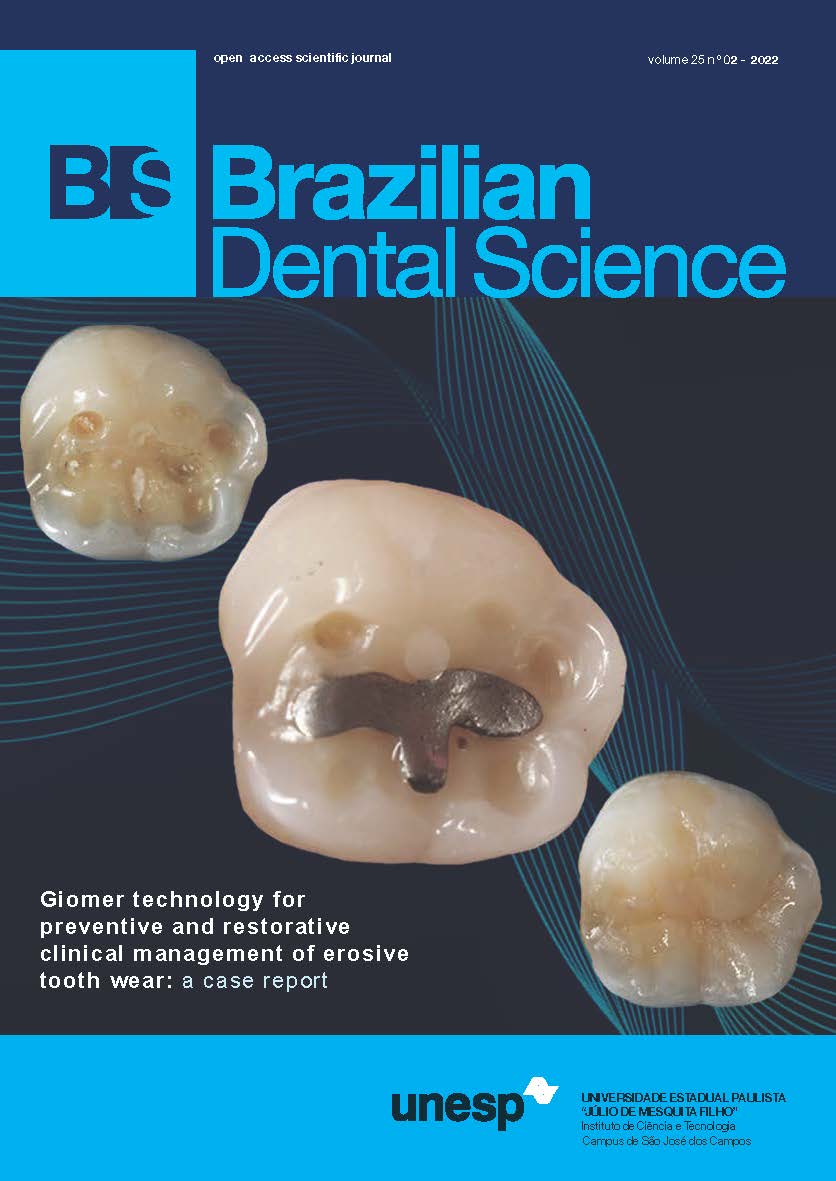Effectiveness of different orthodontic adhesives and a universal bonding resin on the bond strength of brackets to different ceramics
DOI:
https://doi.org/10.4322/bds.2022.e3073Resumo
Objective: The aim of this study was to evaluate the effectiveness of different adhesives on the shear bond
strength (SBS) of brackets bonded to different ceramic materials. Material and Methods: Fifty disk-shaped
specimens were produced from lithium disilicate (IPS e.max CAD) and monolithic zirconia (Cercon) materials.
Each specimen was polished with a three-step diamond polishing system. The polished ceramic surfaces were
conditioned with universal bonding resin (Assure Plus) without pre-treatment, except for two specimens.
Central brackets were bonded onto different ceramic specimens with different adhesives as follows: group 1:
conventional adhesive onto the lithium disilicate; group 2: one-step adhesive onto the lithium disilicate; group
3: conventional adhesive onto the monolithic zirconia; group 4: one-step adhesive onto the monolithic zirconia.
After thermal cycling, the specimens were subjected to the SBS test. The adhesive remnant index (ARI) scores
were also recorded to evaluate bond failure type. Kruskal–Wallis and Mann-Whitney U tests were used for
statistical analysis. Results: There were statistically significant differences among the SBS values (p<0.05). The
monolithic zirconia group with universal bonding resin and conventional orthodontic adhesive demonstrated
the highest SBS value (6.34 MPa) and ARI scores. The lithium disilicate group showed the lowest SBS value
(2.17 MPa) with the same protocol. No adhesive remained on the lithium disilicate specimens. Conclusion: Onestep
adhesive and universal bonding resin combination should not be considered as an alternative for lithium
disilicate and monolithic zirconia restorations. Conventional adhesive and universal bonding resin application
can be effective on non-pretreated ceramic surfaces during orthodontic bonding.
KEYWORDS
Bracket; Ceramics; Hydrophilic bonding resin; One-step adhesive.
Downloads
Downloads
Publicado
Como Citar
Edição
Seção
Licença
TRANSFERÊNCIA DE DIREITOS AUTORAIS E DECLARAÇÃO DE RESPONSABILIDADE
Toda a propriedade de direitos autorais do artigo "____________________________________________________________________" é transferido do autor(es) para a CIÊNCIA ODONTOLÓGICA BRASILEIRA, no caso do trabalho ser publicado. O artigo não foi publicado em outro lugar e não foi submetido simultaneamente para publicação em outra revista.
Vimos por meio deste, atestar que trabalho é original e não apresenta dados manipulados, fraude ou plágio. Fizemos contribuição científica significativa para o estudo e estamos cientes dos dados apresentados e de acordo com a versão final do artigo. Assumimos total responsabilidade pelos aspectos éticos do estudo.
Este texto deve ser impresso e assinado por todos os autores. A versão digitalizada deverá ser apresentada como arquivo suplementar durante o processo de submissão.




























